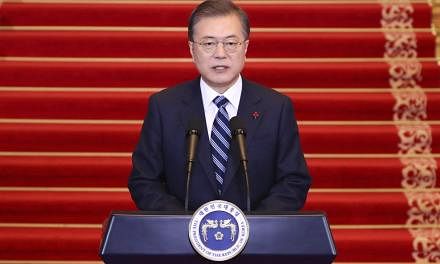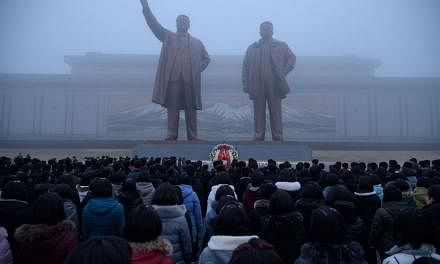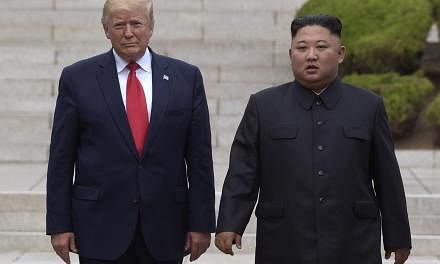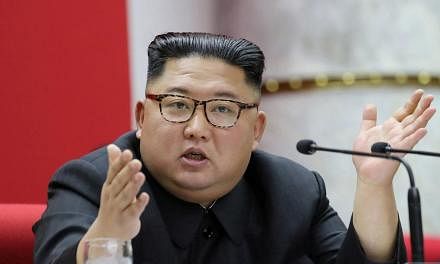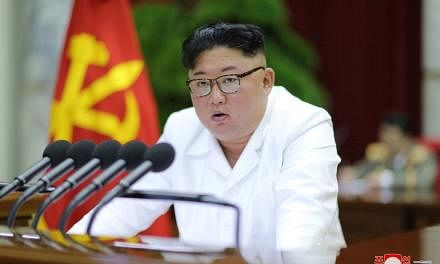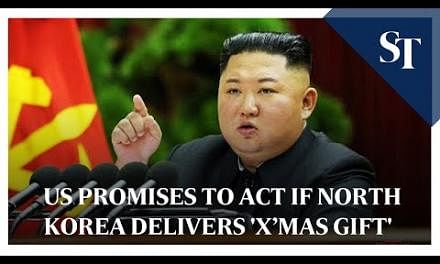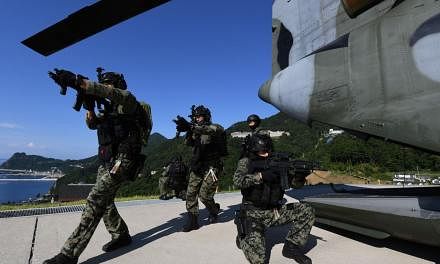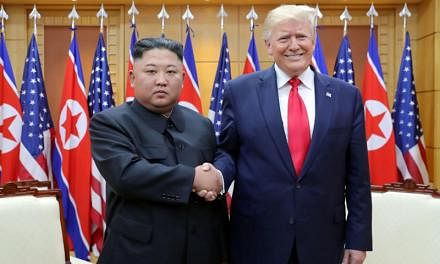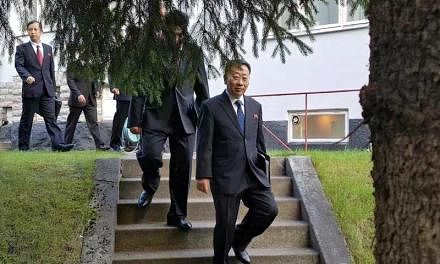SEOUL (NYTIMES) - In the weeks before North Korea fired short-range projectiles on Saturday (May 4), United States President Donald Trump countermanded the Treasury Department, reversing an announcement that it was tightening economic sanctions against the country.
The reason, his press secretary declared, was that "President Trump likes Chairman Kim and he doesn't think these sanctions will be necessary".
Now, nearly a year after beginning a bold experiment in the power of personal diplomacy, Mr Trump has run headlong into its limits. He has discovered that friendship between leaders of bitter nuclear rivals may produce good television, but it is not a counterproliferation strategy.
After gaining few tangible economic benefits from two summit meetings, the North's leader, Mr Kim Jong Un, is turning to a well-worn playbook written by his father and grandfather.
On Saturday, the North fired a volley of projectiles off its east coast in a move that analysts said was intended to escalate the pressure on Mr Trump to return to the negotiating table.
And as Mr Trump heads into the 2020 election, that strategy may threaten what the President has trumpeted as a signature diplomatic initiative, depriving him of the stump-speech moments to declare he brought peace where his predecessors had failed.
In truth, the peace never got very far.
The North has spent the past year producing more nuclear material and fashioning an unknown quantity of it into new weapons, US intelligence agencies told Congress in late January.
And now what the President has described as his biggest achievement on North Korea - a suspension of all nuclear and missile testing - hangs in the balance.
Or so the North appears to be suggesting.
The tests conducted Saturday morning were of "short range" projectiles, South Korean officials said, flying 67km to 200km off Wonsan.
The distance ruled out the possibility that the country had resumed tests of intermediate- or intercontinental-range ballistic missiles, and US and South Korean authorities were analysing flight data to identify the types of weapons that had been fired, the office of President Moon Jae-in of South Korea said.
It is perhaps a measure of Mr Trump's desire to play down provocations and dismiss as old news evidence of expanding nuclear production that he issued an upbeat Twitter post later on Saturday.
"I believe that Kim Jong Un fully realises the great economic potential of North Korea, & will do nothing to interfere or end it," he wrote. "He also knows that I am with him & does not want to break his promise to me. Deal will happen!"
But the weapons tests were the most serious by the North since the country launched its Hwasong-15 intercontinental ballistic missiles in November 2017.
Although North Korea has not gone so far as to renege on its moratorium on nuclear and ICBM tests, which Mr Kim announced last year, the Saturday launch indicated that he was toying with the idea of lifting the suspension, analysts said.
"Today's provocation means that Kim Jong Un is becoming increasingly pessimistic" that he can work out a settlement with Mr Trump, said Mr Lee Byong-chul, a North Korea expert at Kyungnam University's Institute for Far Eastern Studies in Seoul.
"There may be some minor adjustments in the North's behaviour depending on how the US responds, but in the long term, it seems increasingly clear that Kim has decided to go his own way."
The Hanoi meeting in February abruptly ended when Mr Trump rejected Mr Kim's suggestion that Washington lift the most painful of sanctions imposed against his country since 2016 in return for a partial dismantling of its nuclear weapons programme. Mr Trump wanted the quick rollback of the North's entire nuclear weapons programme.
After returning home without badly needed relief from sanctions, Mr Kim said he would give Mr Trump until the end of the year to offer a new proposal.
By gradually increasing the ranges of weapons tests in recent weeks, Mr Kim appeared to be carefully calibrating his options with Mr Trump. Firing short-range weapons may be an attempt to force a breakthrough in the stalled negotiations while not provoking Mr Trump too far, analysts said.
On Sunday, the North's state news agency reported that the weapons tested this weekend were not ballistic missiles, whose tests by the country are banned by UN resolutions, but "large-calibre long-range multiple rocket launchers and tactical guided weapons".
Besides its nuclear weapons, one of the country's most deadly means of strike are its multiple-rocket launchers, which are deployed close to the border with the South, keeping Seoul, the South Korean capital of 10 million, within their range.
In recent years, North Korea has been trying to increase the calibres and ranges of the rocket launchers to be able to target US military bases south of Seoul, as well as enemy ships approaching its coasts, South Korean defence officials and analysts said.
North Korea did not elaborate on what kind of "tactical guided weapons" were tested on Saturday.
The long and tortured experience of negotiations with the North over its nuclear programme is a familiar one.
In an unusually candid interview in recent days with Mr Michael Morell, a former deputy director of the CIA who now hosts the podcast "Intelligence Matters" for CBS, Secretary of State Mike Pompeo noted that "the pattern and practice isn't terribly different this time".
The statement was notable for an administration that has said its approach has diverged entirely from the incremental efforts of four previous administrations.
"It solely turns on whether Chairman Kim makes the fundamental strategic decision" to give up his weapons, Mr Pompeo said, "the one he has told me a half-dozen times he has made, the one he has told the president a handful of times he has made". If the process breaks down, he said, "we'll obviously have to change paths".
It would hardly be the first time a once-promising approach collapsed. President Bill Clinton's signature initiative in 1994, after a nuclear crisis that came perilously close to resuming outright conflict on the Korean peninsula, froze North Korea's nuclear production for several years.
But the North Koreans cheated, buying uranium-enrichment equipment from Pakistan and building an alternative pathway to a bomb, and Congress never fully delivered on its promises of fuel oil and help in building proliferation-resistant nuclear reactors. When President George W. Bush took office and confronted the North, a crisis ensued, and Mr Kim's father tested the country's first nuclear device in 2006.
There have been many tests since, and the North asserted that the most recent, in late 2017, was a hydrogen bomb.
Although it was far from certain that the North had set off a hydrogen bomb, the explosion was far more powerful than any it had set off before. Whether its nuclear weapons can reach a US city is still unclear, which is why a moratorium on testing long-range ballistic missiles is critical.
Mr Kim appears to understand that, and the weapons test on Saturday seemed to suggest that a resumption of long-range tests could be next.
The move could threaten his recent rapprochement with China, his main conduit for food and energy, and a new opening to Russia that began with a meeting with President Vladimir Putin last month.
But for a country that Mr Trump pays attention to only because of its nuclear arsenal, it may be the only play Mr Kim has. And he recognises that he has only one form of leverage - threatening the deal that Mr Trump so desires.

